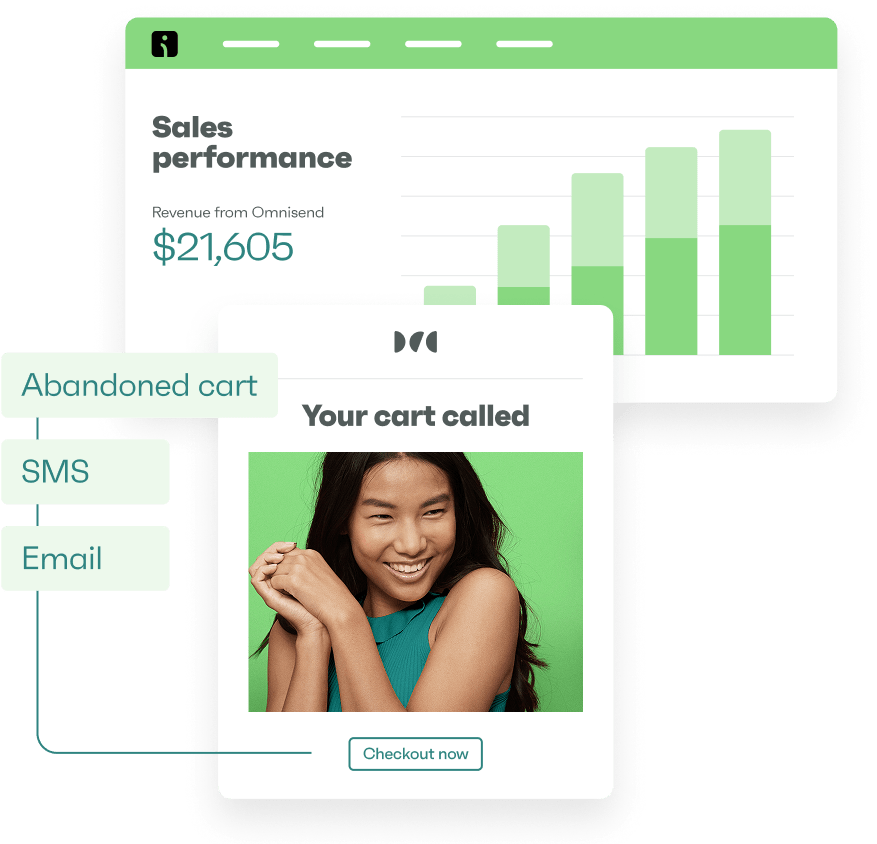Drive sales on autopilot with ecommerce-focused features
See FeaturesMany businesses don’t realize that email marketing and SEO aren’t separate strategies. They complement each other, amplifying results. Successful brands use them in a winning combination.
SEO boosts website rankings, while email marketing engages your audience directly. As a result, this drives more visits to your site and supports SEO efforts.
You’re probably thinking, “How does a strategy used for improving search rankings integrate with a strategy used to engage, convert, and retain customers?” Well, their collaboration is valuable because they both share the goal of connecting with the right target audience and getting them to take action.
Put simply, you can send targeted email campaigns to encourage your subscribers to visit your blogs or landing pages. This can then heighten traffic, improve engagement, and amplify your SEO efforts.
In this article, we’ll explore some of the best tips and strategies for email marketing and SEO to build authority and increase traffic and conversions.
Quick sign up | No credit card required
Understanding SEO fundamentals
SEO aims to help search engines like Google find, understand, and rank your content. This involves three processes:
- Crawling: Search engine bots (crawlers) visit your homepage, follow links, and discover more content to index it
- Indexing: Once content is discovered, it’s stored in a vast database called the index
- Ranking: After indexing, search engines decide where to display your content in search pages based on relevance, quality, and usability
To help this process run smoothly, a sitemap is essential. It acts as a roadmap to help crawlers find your pages. You’ll also need a clear website structure to help visitors easily navigate your site and engage with your content.
Also, your website content should be optimized with the right keywords. This will help search engines match your content with relevant user searches, eventually improving your SERP ranking.
According to an analysis by First Sage Page, websites in the first position of SERPs typically have a 39.8% click-through rate, compared to 1.9% for those in the ninth position. This is why a high ranking is essential.
This is where email-driven traffic cuts out the competition and drives traffic directly to your site.
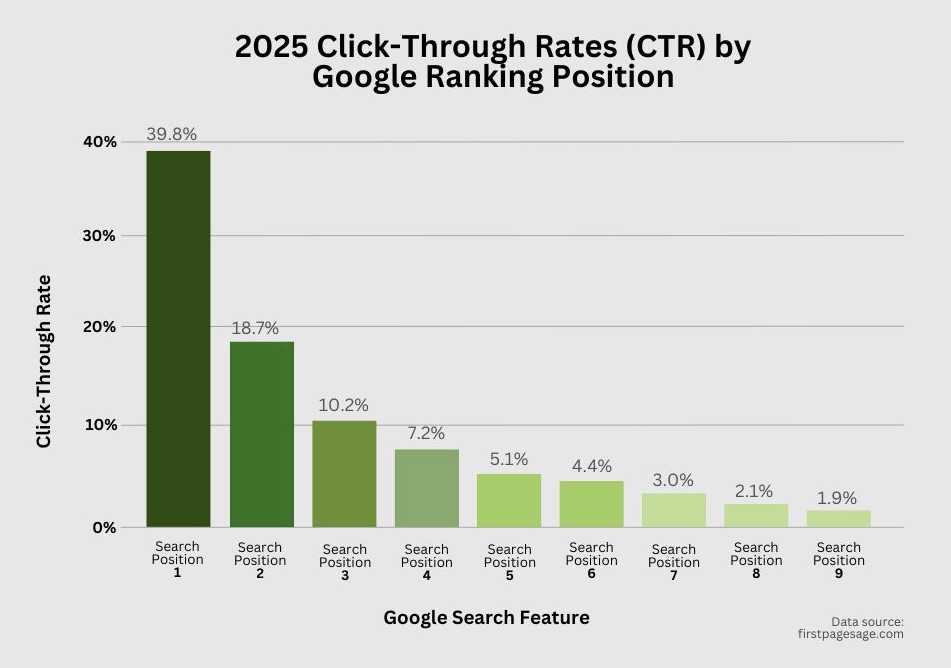
How email marketing impacts SEO
Email marketing’s influence extends past the inbox. Email marketing for SEO helps drive traffic, increase engagement, build backlinks, and amplify content reach. When combined strategically, email marketing and SEO create a powerful loop for organic growth. Here’s how:
1. Increased website traffic
When you feature your website content in your emails, you can direct traffic to your website. You can also tap into your loyal email list and encourage them to click through, which can indirectly boost your search rankings.
Since your subscribers are already interested in your brand, they’re more likely to engage with your emails. The key is encouraging them to click links that lead to your website, thereby increasing traffic.
Additionally, when they land on your website and engage, this can then improve your SEO performance and elevate your search rankings over time.
2. Higher engagement metrics
Email marketing can significantly improve engagement metrics, such as time spent on a page, pages per session, and bounce rate, by driving more intentional traffic to your website.
Visitors who arrive from email campaigns are motivated by specific content. This often leads to higher engagement, increasing their time spent on your site and encouraging them to explore additional pages.
Plus, email campaigns can reduce bounce rates by attracting an audience that’s already interested in your brand. This further boosts pages per session and improves overall SEO performance.
3. More backlink opportunities
An effective way to enhance off-page SEO factors, such as backlinks, is through email marketing strategies. Backlinks are links from external websites that point to your site.
They play a crucial role in SEO because high-quality backlinks on your website contribute to higher domain authority.
To build more backlinks, you can reach out to high-authority websites. If they find your content helpful, they might link back to your website. This then enhances your site’s authority.
In short, email marketing and SEO go hand in hand as email campaigns attract quality traffic that acts as a gateway to generating organic backlinks.
4. Improved content distribution
Content distribution in SEO and email marketing refers to using email campaigns to share content like blog posts, infographics, and videos.
For example, an email campaign might feature a brief snippet of a blog post to pique interest and prompt the reader to click through to the full content. Similarly, infographics can be spotlighted in emails, with links to view or download them from your website. Infographics are highly shareable, which also increases backlink opportunities.
Another effective method is distributing videos, such as tutorials or product explainers, through video newsletters. Videos capture more attention than text or image-only emails, which leads to higher engagement rates.
5. Encouraging social sharing through emails
This involves including social sharing buttons in your email campaigns. These are clickable icons representing platforms like Facebook, X, LinkedIn, and Instagram.
These buttons make it easy for readers to share your blog posts, videos, or infographics on social media with just one click.
As more people share your content, your visibility increases and your reach widens. This heightened social media presence can drive more branded searches, signaling to search engines that your brand is gaining traction and relevance.
This is because search engines consider a higher volume of branded searches as an indicator of a trustworthy website, which can positively impact your SEO.
Best strategies for combining email marketing and SEO
For email marketing and SEO to work at their best, it’s essential to implement well-planned content strategies that connect the two seamlessly. Simply adding a few links to your campaigns won’t cut it. It requires a strategic approach to ensure both channels amplify each other effectively.
1. Promote high-value content through email
Whether it’s blog posts, whitepapers, or infographics, create high-quality content that educates, informs, or solves a problem for the reader. Other examples include industry trend reports or expert interviews, such as Q&A sessions with industry or thought leaders.
High-value content can also include personalized pieces, such as a curated collection of blog posts promoted through email digests in weekly or monthly roundups. These digests help the audience engage with more valuable content all at once, supporting your email marketing and SEO goals.
For example, Design Modo’s email digest begins by featuring the best tools for designers, marketers, and developers, with a “Learn More” CTA to drive engagement. It then offers free kits for designers, accompanied by a “Download Now” button to encourage immediate action:

2. Use emails to build backlinks
A key strategy in leveraging emails to build backlinks is using linkable assets. A linkable asset is a valuable piece of content, such as an infographic, video, article, or online tool.
Promote these assets by highlighting their value and providing easy ways for recipients to share them, such as direct links or embed codes. This increases the likelihood of them linking back to your content, thereby building organic backlinks.
For instance, bloggers or influencers who are part of your email list may share your content on their websites. This link to your original asset helps improve your search rankings over time.
3. Conduct surveys and gather feedback
Email surveys gather information on subscribers’ opinions, preferences, and experiences. They are typically short and engaging, with multiple-choice or rating scales.
Once collected, responses can be analyzed and transformed into SEO-driven content, such as blog posts or infographics.
Survey results provide insights into audience interests and help identify SEO gaps in existing content.
For example, this survey email from Litmus starts by providing information about a topic and encourages readers to click the CTA to get more information. It then asks the user to answer a few questions so the brand can properly personalize its content to suit its audience’s preferences.
This is an example of email marketing and SEO working together to directly engage the audience, collect valuable data, and create content opportunities to improve SEO:
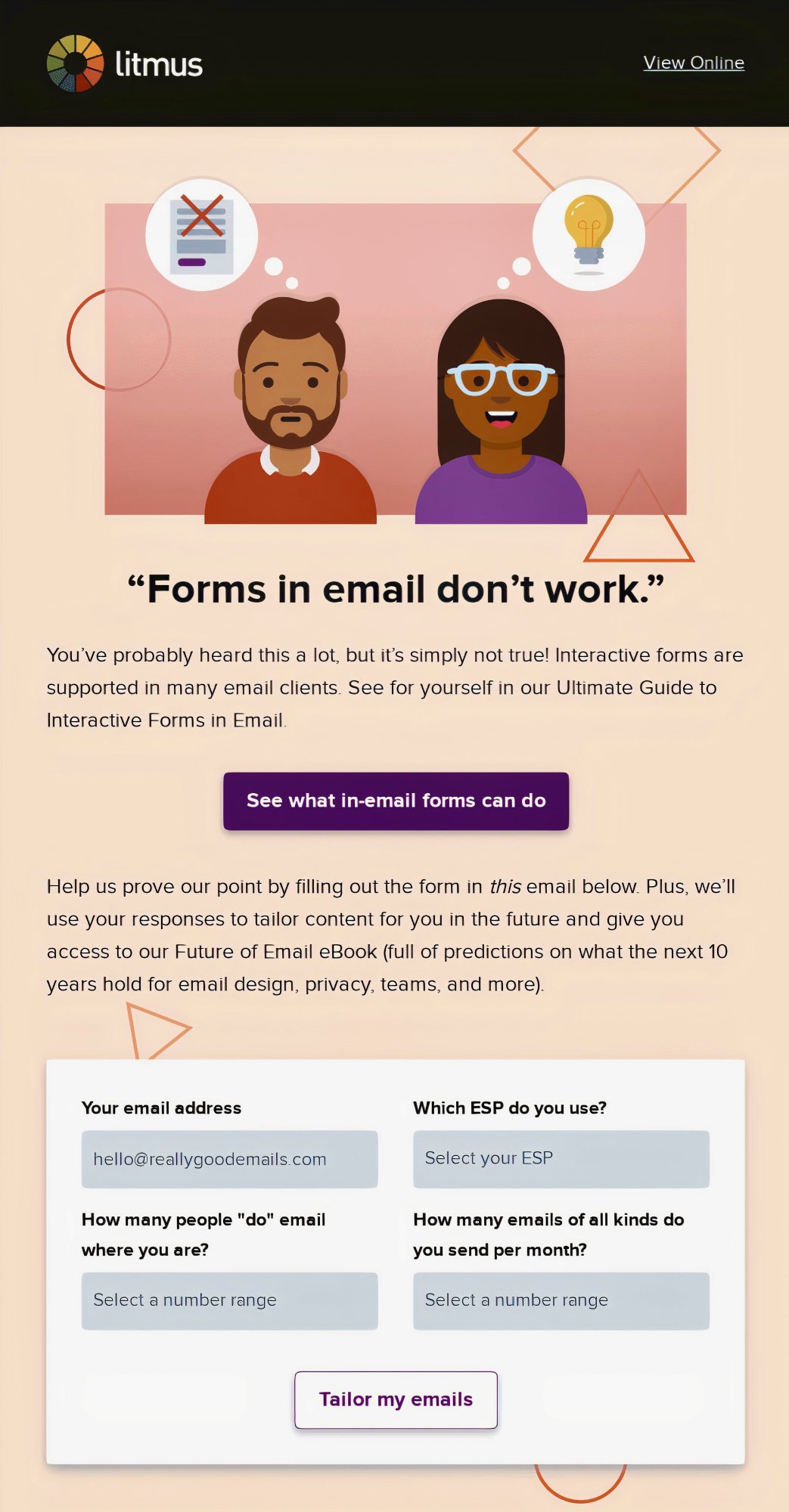
4. Build an email list through SEO efforts
Your SEO efforts can include improving site speed, using the right keywords, and creating valuable content. These efforts help visitors discover your website. The resulting organic traffic can help increase your email newsletter signups, especially when paired with incentives like free ebooks or exclusive content.
You can also repurpose content from your email newsletters by creating a newsletter archive. This is a section on your website where you publish past newsletters. It gives site visitors a glimpse of what they might have missed by not subscribing and urges them to sign up.
5. Optimize email CTAs for SEO
Creating powerful CTAs involves ensuring the links you include in your emails lead to highly relevant content and contain targeted keywords.
In addition, it’s important to design CTAs that are clear, concise, and action-oriented. Use direct, compelling language that clearly tells the reader what to do next.
You must also create CTAs that stand out within the email. Use contrasting colors or larger font sizes to draw attention without overshadowing the content. This will encourage more clicks, bringing more traffic to your website.
For example, this Old Pal email begins with a compelling headline and provides information about Delta-9 THC to spark curiosity. Following the snippet of information is a CTA that reads “READ ALL ABOUT IT” in a larger font against a bright color.
The email then guides readers through new product options, with a second CTA promoting a sale. Each CTA is strategically placed to move the reader through the email in a natural progression from education to conversion:
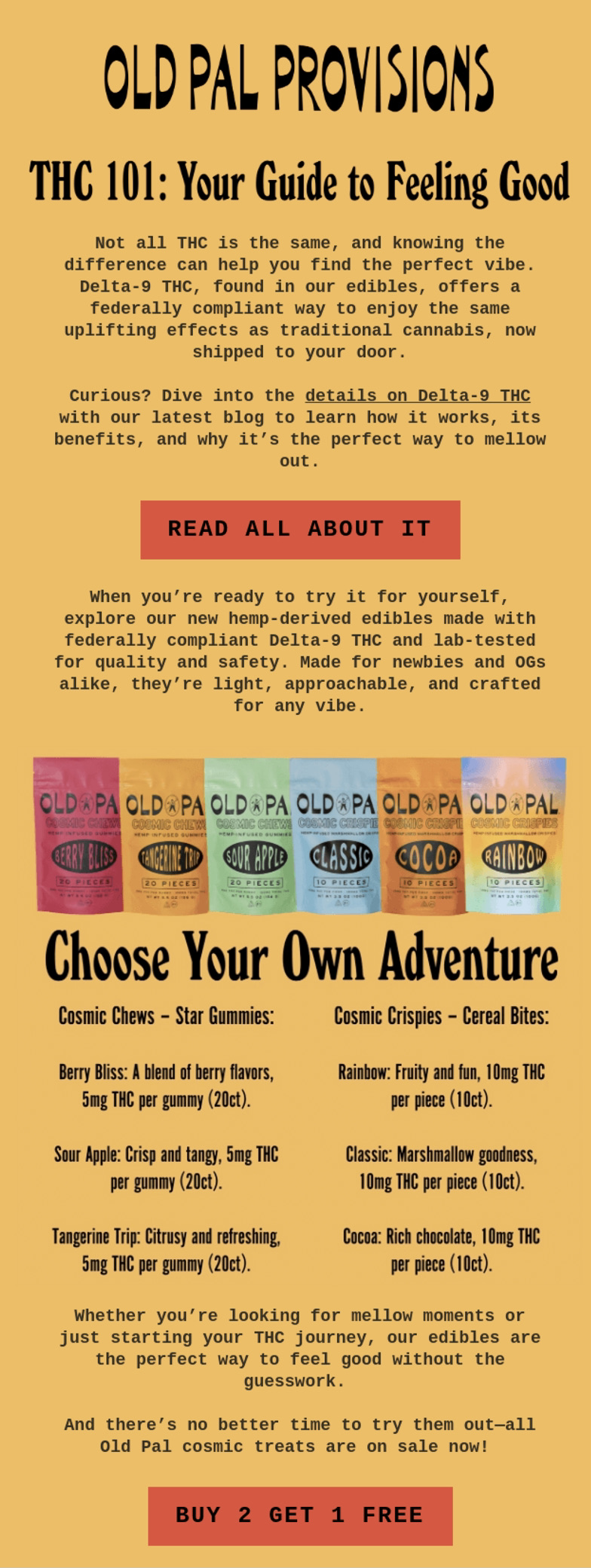
6. Segment your audience
Email segmentation involves dividing your subscriber list into smaller groups based on specific criteria, such as demographics, behaviors, or purchase history.
It can also be based on where audiences are in their customer journey — awareness, consideration, or decision. The goal of email segmentation is to create tailored content that your specific audience can resonate with.
For example, sending educational content to prospects in the awareness stage helps build trust. Meanwhile, providing product demos to those in the decision phase increases conversions.
Email segmentation also helps improve customer satisfaction and retention — as customers feel valued and seen — while ensuring that marketing resources are utilized efficiently.
The key to this strategy lies in gathering and organizing the right data to use in your email marketing and SEO strategy. Consider using automated segmentation tools like Omnisend to help you build segments.
Its segment builder automatically generates suggestions for segmentation, making it easier to personalize content:

7. Use A/B testing to refine campaigns
Blindly executing your email strategy can hinder traffic and revenue growth. A/B testing shows which email elements have the potential to convert and which don’t.
By testing various elements of your email campaigns, such as subject lines, designs, and CTAs, you can identify which variations perform best.
A/B testing removes the guesswork from campaign creation. So, when you choose an email marketing automation tool, consider one that has an inbuilt A/B testing feature.
One such tool is Omnisend, which allows you to create two versions of your campaigns and send them to selected recipients. You can then measure each version’s success based on metrics like open and click-through rates.
The version that performs better will automatically be sent to the remaining recipients.
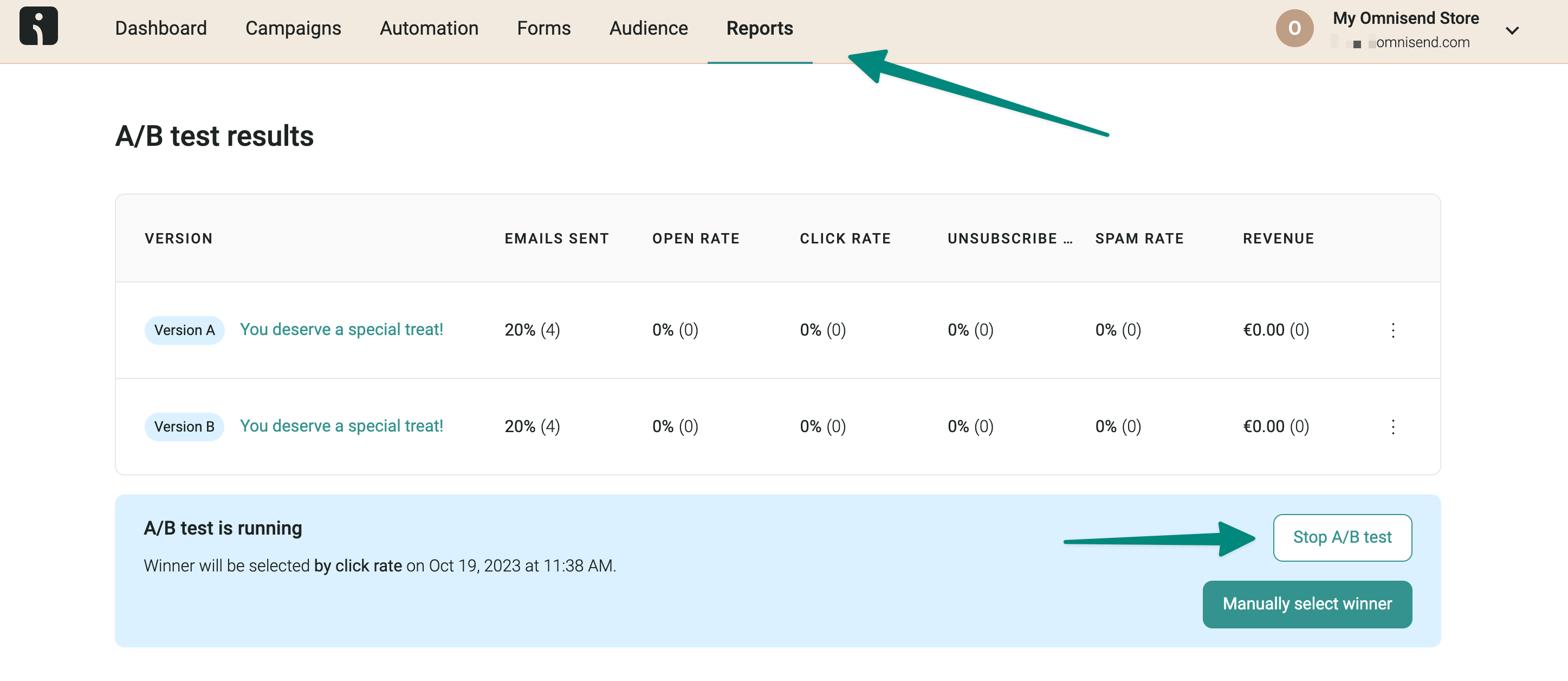
8. Consistent branding across channels
This strategy is about ensuring that your messaging, tone, visuals, and overall identity remain consistent across your website and email campaigns.
For example, if your blog post uses a friendly, educational tone, your email campaigns should mirror that while maintaining consistent brand colors and visual themes.
A cohesive design across emails, websites, and other marketing materials also helps reinforce brand recognition and build trust.
To implement consistent branding, develop clear brand guidelines that detail your tone of voice, core messaging, color palette, and overall visual style.
This significantly improves user experience and ensures a seamless brand identity across all customer touchpoints, further amplifying your email marketing and SEO efforts.
9. Track campaign performance
If you’ve already optimized and implemented your content strategy, you need to track what’s working and what isn’t so you can adjust your email marketing and SEO strategy accordingly.
Analyze key factors, such as whether emails are driving quality traffic to your site and if users are engaging with the content. For example, a high bounce rate may indicate a disconnect between email expectations and the landing page, requiring adjustments in messaging or design.
You should also track open and click-through rates to have a comprehensive understanding of how your campaign works.
If you’re sending out a large number of email campaigns, gathering this data becomes even more crucial — but also more challenging. Consider using email analytics tools like Omnisend to streamline performance tracking:
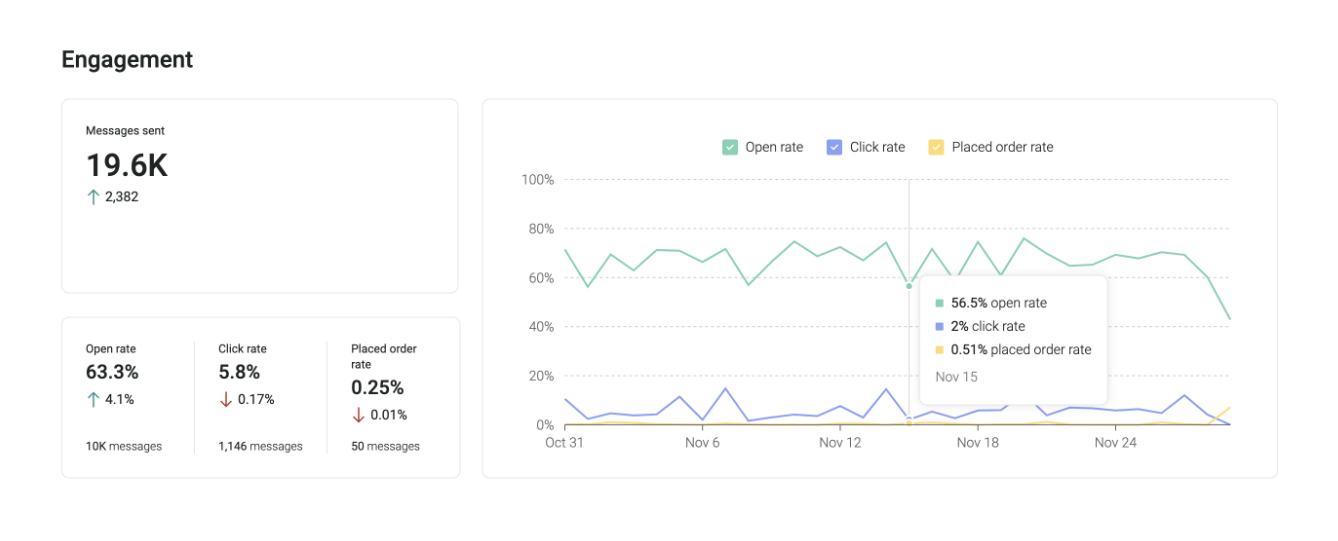
After assessing email performance, monitor its impact on SEO-related metrics like traffic and user engagement. To track site visits from your email, add UTM parameters to your links. After visitors land on your site, track metrics like time on page and bounce rates. Then, optimize your website accordingly.
Quick sign up | No credit card required
Email metrics that influence SEO
Email metrics are critical indicators of content quality and user engagement. Understanding how these metrics influence search engine algorithms can help you adjust your strategies to achieve optimal results.
Here are a few important email metrics that influence SEO:
1. Click-through rates (CTR)
A consistently high email CTR indicates that your content is compelling and driving quality traffic to your website. The more engaged these visitors are, the more positively it can impact SEO performance.
However, the type of content you’re linking to can elevate your rankings even more. For example, linking to long-form, in-depth articles or pillar content can improve user retention and time on page. This makes them more likely to take action on your website.
Crafting email CTAs that point to well-optimized, authoritative content boosts both CTR and your site’s overall SEO performance.
2. Time on page
Email campaigns can significantly influence time on page by leading readers to engaging, optimized landing pages.
The best practices for landing page optimization include compelling headlines, clear CTAs, and mobile optimization. Additionally, a well-structured design, fast load times, and engaging content can prompt visitors to stay longer on your site.
When visitors stay longer, search engines recognize the content as valuable, elevating your rankings.
Improved rankings drive organic traffic, which enhances dwell time as users spend more time on the page after finding it in search results. This synergy between email marketing and SEO creates a cycle of increasing engagement and visibility.
3. Social shares
When subscribers share your content on social media, it creates social signals. These include likes, comments, and shares that amplify visibility, increase backlinks, and encourage branded searches. This highlights the mutually beneficial relationship between email marketing and SEO.
To help achieve this, you can promote shareable content through email campaigns. This creates opportunities for your audience to expand and engage with your website, indirectly supporting your SEO efforts.
Conclusion
Email marketing and SEO are powerful strategies that, when combined, can significantly enhance your online presence and maximize your ROI. You can integrate these strategies by creating high-value SEO content and promoting it through emails to gain backlink opportunities and build a solid email list.
To maximize email marketing and SEO results, focus on optimizing CTAs and segmenting your audience. Don’t forget the value of conducting surveys and using A/B testing to ensure that your content resonates with your audience.
Lastly, add consistent branding across all channels and track key metrics like engagement rates, time on page, pages per session, and social shares.
That said, email marketing and SEO require attention to detail, which can be difficult to achieve without the right tools. Consider email automation tools, such as Omnisend, to streamline the process of implementing and improving these strategies without worrying about missed opportunities.
Quick sign up | No credit card required
TABLE OF CONTENTS
TABLE OF CONTENTS


No fluff, no spam, no corporate filler. Just a friendly letter, twice a month.

 OFFER
OFFER







